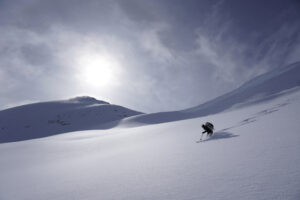By Sydney Toni
Media Coordinator, Know the North
It’s been more than 40 days since the Know the North expedition hit the water in Wollaston Lake, Saskatchewan with boats almost too full to float. Though the seven young explorers set sail in sunny weather, they’ve faced biting cold, battled headwinds and dragged their boats up dry waterways — and they are in awe of the beauty that surrounds them. Though some members of the trip optimistically brought along shorts, they’ve only seen eight days without rain so far.
The first week of the trip was spent traveling from Wollaston Lake to the border of Manitoba. Grey skies and strong winds bid them a feisty welcome to the north. The constant light has allowed them to paddle sixteen-hour days, stopping on eskers for lunch alongside the tracks of caribou, wolves, moose and bears. On portages, they’ve often crossed paths with animals, some unwelcome, such as grizzly bears and a charging moose.
After reaching the northernmost point on the Cochrane River in Manitoba, the trip portaged onto the Thlewiaza River and headed toward an upstream slog on the Little Partridge River. This route proved to be very different from how it looked on the map. After spending six days on Little Partridge dragging and portaging their boats, they reached water deep enough to paddle into Kasba Lake, which straddles the border of Nunavut and the Northwest Territories.
Since then, they’ve arced their way back towards the Seal River in northern Manitoba. On day 36, the group caught sight of the northern lights — once it was finally dark enough to spot their sinuous glow. They’ve been continually surprised and humbled by the wilderness. They’ve been attacked by birds defending their young, they’ve spotted a wolverine from a distance, and, once, caught a glimpse of a white wolf. At every turn, the journey offers something new and unplanned.
When the explorers set out, it was with the intent of pitting maps and plans against the land. As the trip nears its end on August 18 in Hudson Bay, they’ve realized that travelling this region once is not enough to truly know it. Passing through is enough to briefly take stock of a moment in time, nothing more.




